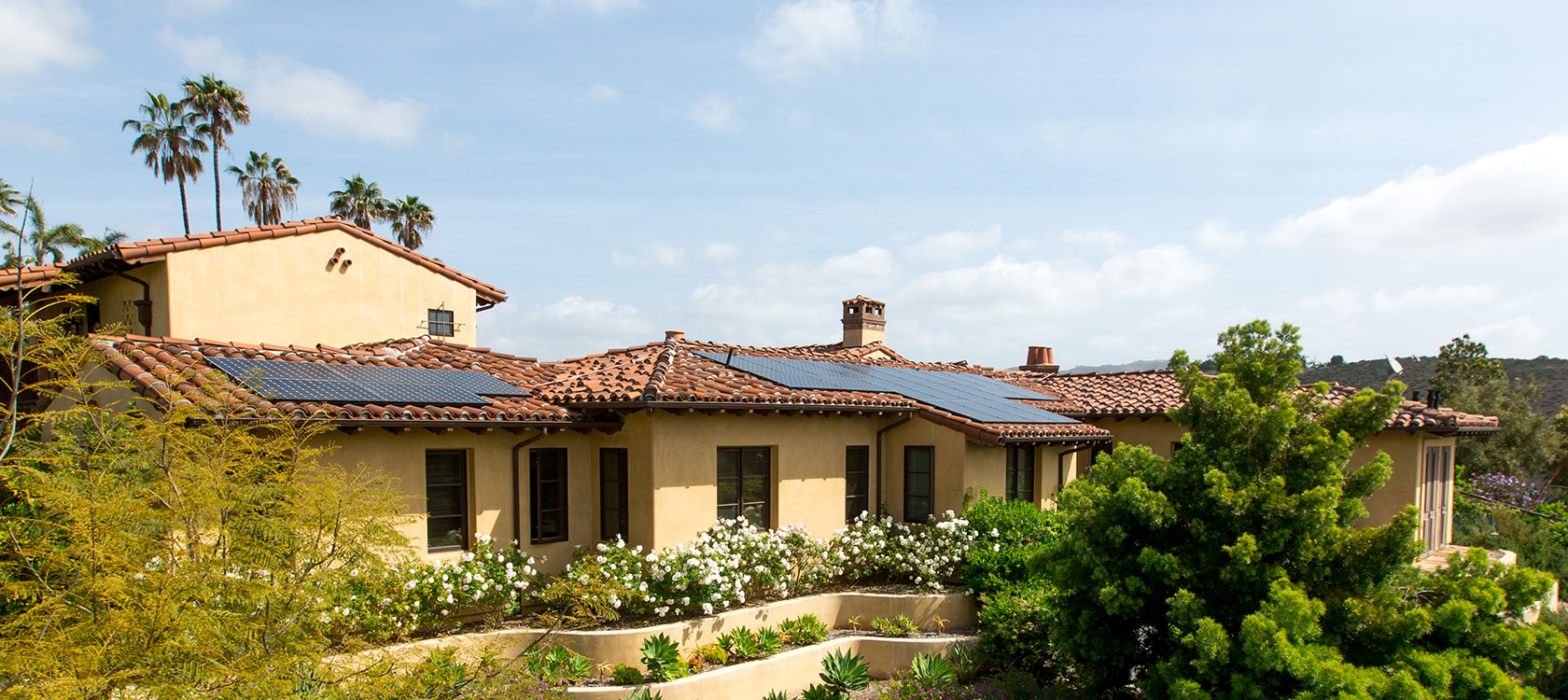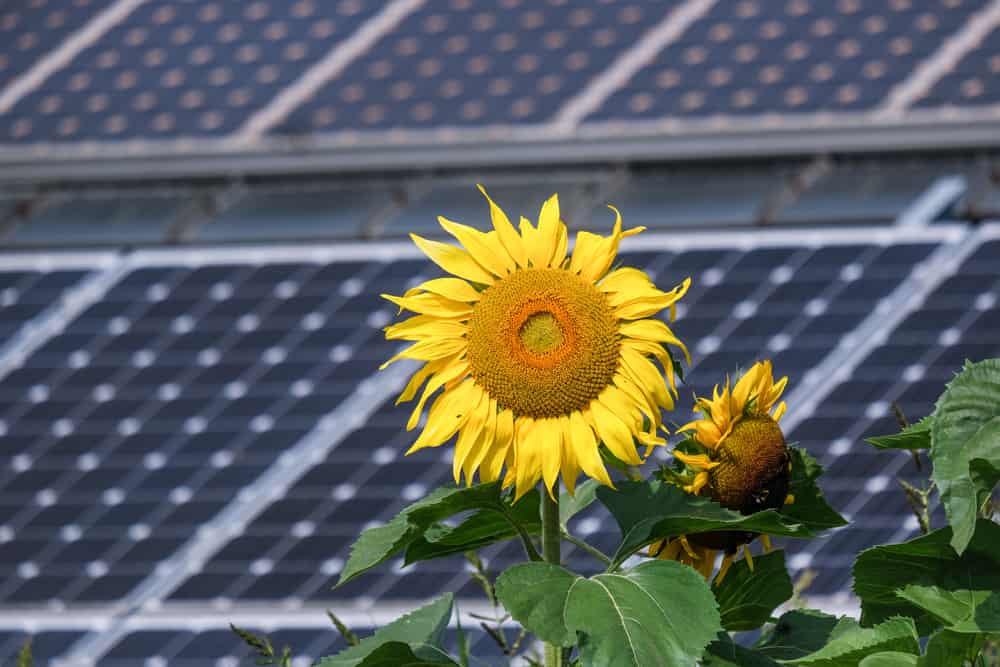
Yes. But wait: there’s more!
When asking “can solar panels be installed flat?” it’s important to consider the variety of available roofing styles and materials, which are sometimes determined by just how “flat” your roof really is.
This raises a follow-up question: will you need brackets to install solar panels? The answer here also depends on your flat roof’s slope, as well as the materials used in its construction.
Before we get into mounting brackets, let’s look at some technical terms to help you understand how the whole thing works.
Is Your Roof Really Flat?
Remember when you thought the day would never come when you’d actually use that high school geometry class? Well, it’s here now.
Builders measure a roof’s slope (or “pitch”) as rise over run, in terms of inches. This means a roof with a slope of 4:12 will increase vertically (rise) by 4 inches for every 12 inches of horizontal travel (run).
In general, even “flat” roofs have slopes ranging from 0:12 to 2:12, and most still employ some amount of slope for water drainage. The same slope expressed in inches can also be expressed as an angle (in degrees), or as a grade (percentage). For example, a roof with a 2:12 slope has an angle of 9.46º, and a 16.67% grade.
All of this math is helpful for understanding the ultimate goal of your installation: to capture the maximum amount of sunlight with the panels. One reliable guideline suggests the angle from the rooftop’s surface should be roughly equal to the property’s latitude. In Southern California, this means the panels need to be angled at roughly 30-32 degrees.
Finding an experienced solar installation expert, however, is probably the biggest consideration to ensure a successful home system: they should be able to overcome any hurdles to installing solar panels, whether your roof is flat or sloped.
Types of Flat Roofs
Common construction materials include:
- Asphalt shingles
- Clay or concrete tiles
- Metal panels
- Mineral-surfaced roll roofing
- Built-up roofing
- Modified bitumen systems
- Other liquid applications that dry to form a seal
A combination of factors, including the roof’s age, sunlight exposure (UV radiation), and a propensity for leaks, means flat roofs often reflect their wear and tear more easily than sloped roofs. For example, tar and gravel roofs have estimated lifespans of 25 years, which compares well to shingle roofs. However, the “life” is contingent upon regular maintenance to keep the gravel surface fresh, and firmly affixed to the tar. Adding solar panels to this roof type could possibly complicate—or otherwise change—the required maintenance regimen, so it is best to consult a professional solar installer.
For Flat Roofs
If your roof is parallel to the ground, installing solar panels can be a straightforward process. While installing photovoltaic (PV) shingles requires a minimum slope of 2:12, solar panels can indeed be installed flat on such a roof—as long as a slight angle still exists between it and the PV panels.
To ensure success, your solar panel expert will likely make several design decisions prior to attaching the panels to your roof. These may include the use of mounting brackets or other devices to optimize the angle of your panels.
While wind is generally not a major concern in Southern California, stronger gusts could cause some lifting of your solar panels. As a result, installers may compensate by incorporating extra ballast (weight), using anchors that drill into the roof surface, or a combination of the two.
For Sloped Roofs
Homeowners with sloped roofs—4:12 or more—can choose from a myriad of installation options. They can be mounted flat to existing shingles without special brackets for angling purposes, or installed with a greater slope than the roof on the southern exposure to capture more sunlight. Your solar expert can help you choose the best option for your particular home.
Solar Shingles and Sloped Roofs
A key advantage of sloped roofs is the option to use solar shingles. These solar panels are designed to be installed either on top of existing roofs or in place of existing shingles. There are numerous benefits to solar shingles, but some of the biggest advantages include maintaining aesthetic cohesion with your home’s exterior and meeting homeowner association requirements.
Because they place no additional weight on the rooftop, and require no drilling into structural members, solar shingles present fewer installation issues. They also create fewer (if any) rooftop obstructions for antennas, dishes, dormers, and the like.
Solar shingles may be best suited for homeowners who are already in the market for roof repair, or looking for a durable long-term replacement option. In addition, they may not necessarily be as efficient as a solar panel system at gathering sunlight without adjustment if the slope is greater than or lower than 8:12.
For Every Roof
You may want to ask your solar specialist to calculate the change in relative efficiency of photovoltaic panels, so you know your system is performing at maximum efficacy. You already know that roof slopes are measured in terms of inches as rise:run. In terms of solar shingle performance, converting those rise:run ratios into angles illustrates a significant variance.
For example, the angle of an 8:12 roof is 33.69 degrees, but for a 4:12 roof it’s only 18 degrees. Since the ideal angle for solar panels in Southern California is around 30 degrees, this 12-degree discrepancy can make a significant difference in how much sunlight your panels are able to capture.
Selecting Solar Panels for Flat Installation
Many factors can influence how you select solar panels that can be installed flat. Understanding the mounting options for both flat and sloped roofs is a good starting point, as well as being aware of existing neighborhood design and planning restrictions for your home.
The best way to ensure a solar system meets your electricity generation goals, aesthetics, and your budget is to work with experienced installers whose designs encompass a variety of roofing styles and materials. Partner with experts who understand how to install solar panels at the optimal angle for sloped or flat roofs.




